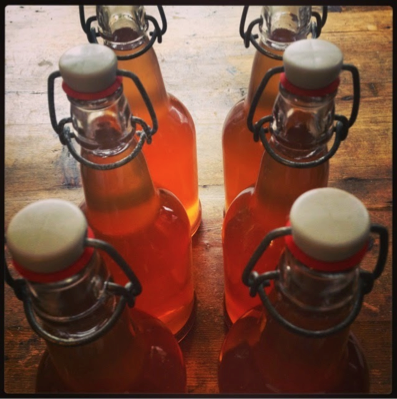 What is kombucha?
What is kombucha?
kom·bu·cha
kômˈbo͞oCHə
Kombucha is a popular effervescent fermented tea said to be full of probiotics, B vitamins, antioxidants, and much more. For me, it is reminiscent of a carbonated, slightly sour apple cider beverage. Kombucha’s long list of purported health benefits have not been substantiated by clinical trials, but regular drinkers offer many testimonials of its healing properties.
The list includes:
- Probiotics
- Antioxidants
- High in polyphenols
- Balances internal pH
- Increases metabolism
- Improves digestion
- Helps with arthritis
- Alleviates constipation
- Helps with chronic fatigue
- Relieves headaches, migraines, and hangovers
- Reduces kidney stones
- Improves eyesight
- Aids healthy cell regeneration
Personally, I became interested in kombucha for its digestive benefits. Kombucha is loaded with beneficial probiotic organisms linked to digestive health and immune function. Drinking kombucha before, during, or after a meal is said to help break down food and make the nutrients more bioavailable. I have found food digests more easily for me since I started drinking kombucha, and I have less digestive issues such as acid reflux and indigestion.
The Tea of Immortality
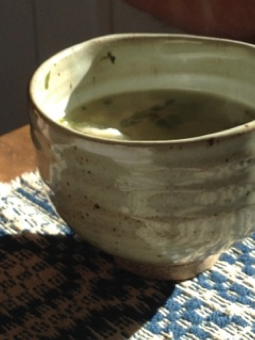 The origins of kombucha have become vague with time, but it is thought to have originated in the Far East, most likely China during the Tsin Dynasty, and has been consumed there in many households for at least two thousand years. The first recorded use of kombucha comes from China in 221 B.C. It was known as “The Tea of Immortality.”
The origins of kombucha have become vague with time, but it is thought to have originated in the Far East, most likely China during the Tsin Dynasty, and has been consumed there in many households for at least two thousand years. The first recorded use of kombucha comes from China in 221 B.C. It was known as “The Tea of Immortality.”
Kombucha hit the Silk Road and traveled widely throughout Eastern Europe, Russia, and Japan. It is believed that the word “kombucha” originated in Japan in 415 A.D. A Korean physician called Kombu or Kambu treated the Emperor Inyko with the tea and it took his name, “Kombu” and “cha,” meaning tea. The use of kombucha waned around World War II. After the war, Dr. Rudolph Skelnar sparked a new interest in kombucha in Germany when he used it in his practice to treat cancer patients, metabolic disorders, high blood pressure, and diabetes.
How is Kombucha made?
Kombucha is relatively simple to make for the home DIY brewer. Combine brewed black or green tea + sugar + water + SCOBY + flavoring + fermentation, and you have kombucha.
Scoby “mothers” can be purchased at Fifth Season Gardening and include easy to follow directions for brewing your own kombucha. SCOBY is an acronym for Symbiotic Colony of Bacteria and Yeast. A scoby contains one or more species each of bacteria and yeasts, which form a zoogleal mat known as a mother. The mother looks sort of like a mushroom or gooey fungus. It’s not really very pretty… and it will grow and multiply!
The beneficial bacteria and yeasts in the scoby work synergistically to produce a certain type of ferment, which in turn produces the purported healing properties of kombucha. The scoby you buy at Fifth Season will come with an easy to follow page of instruction for a single half-gallon brew or a continuous brew method. Fifth Season has everything you need to get started, including glass-brewing jars, grain bags, funnels, and EZ cap bottles for attractive bottling of your brew.
Let’s get started!
Items you will need:
- Kombucha starter kit (available at Fifth Season)
- 1 gallon glass jar for the ferment (Fifth Season has these too!). Do NOT use metal or plastic.
- Large pot you can brew tea in, stainless is best to avoid contamination. Do NOT use ceramic or cast iron.
- Cheesecloth or some other breathable cloth to cover ferment jar and a rubber band to hold cloth tightly. Round coffee filters also work.
- Organic black or green tea, get the best quality you can afford.
- Filtered water, no chlorine.
- If you use loose leaf tea, Fifth Season has bags for this (look for the grain bags in the brew area). Some people like to add dried herbs, but check for toxicity and SCOBY interactions first. Use separate scoby for herbal brews.
- Organic pure cane sugar (I like the Whole Foods brand)
- Bottles or jars for the brew. I prefer the EZ cap bottles from Fifth Season (no worries of carbonation explosions!).
- A plastic funnel (NO metal).
- A small dish to rest your scoby in his helpful.
Helpful tips
- Make sure your brewed tea has COOLED! A hot tea will kill your scoby and you will have wasted your money.
- Avoid using metal utensils, it may affect taste.
- ALWAYS have everything sanitized and clean clean clean to avoid contamination.
- Sometimes the kombucha that you bottle likes to settle in at the bottom and stay even after a good dishwasher cycle. One Step cleaner will clean those bottles thoroughly (available at Fifth Season in the brew section).
- DO NOT refrigerate your scoby.
- Avoid dramatic explosions by burping your jars during the second ferment. Trust me…
- Definitely use that rubber band to hold the cloth tight around your ferment jar. This will avoid a fruit fly episode.
- Splurge a bit and buy the EZ cap bottles. They work great, you don’t have to fear exploding glass, and they are visually attractive in the fridge. If you are going to go to all the trouble to brew kombucha, it might as well look impressive!
- Regarding using fruits for flavoring: you will see many recipes online that tell you to just go ahead and add fruit. They never tell you that if you shove a blueberry in that is just a bit too large for the mouth of the bottle, it won’t come back out and will also block the mouth of the bottle when you try to drink. They also don’t tell you that the ferment leaches the color from the raspberries and end up making them look a bit unpleasant floating around in your ‘bucha. I think juices are better, though small blueberries floating around can be pretty. Ginger flavors best when grated, long strips will shoot right down your throat if you take a big swig and forget the ginger spear is in there.
- Have a little dish to lay your scoby in so you aren’t standing around holding it and trying to figure out what to do with it when you are ready to decant the brew into bottles. Later you can put it in a tightly sealed jar with a cup or two of the brewed tea. Don’t forget to do that, you will use that tea for your next brew.
- RE: above — save a cup or two of brewed tea before you bottle. It’s best drawn from the top of the brew. Put your scoby in this. I just saved the jar my mother scoby came in for this purpose.
- You will see little tentacles and stringy brown things floating around during the first ferment. Settle down, it’s okay, just bacteria and yeast at work. If you see mold, this is not a good thing. You will know, because it will stink. A good ferment smells a tiny bit sour, with a hint of vinegar, but mostly like sweet tea with ambition. You will know the difference.
- It’s good to brew your own, because you can adjust the flavor you want. Every couple of days, give it a taste, and when it’s right for your taste, bottle it up. I find a good way to do a taste test is to dip in a straw with my thumb covering one end, and siphon. Make sure the straw is clean.
- I like to let my first ferment sit for a week, or 7 days. After you bottle your brew, it can sit for a while, or it can sit for a day. For my first brew, I went three days longer because I was scared. Go longer, don’t be scared! You will get more carbonation the longer it sits, but I would say max time would be around 14 days at most.
- After you put your kombucha in the refrigerator, the fermenting ceases.
For my first brew, I skimmed the directions, collected things as I went, and just sort of dove in, thinking to myself “I got this.” NOPE… Sit down, slow down, read through directions, or watch a youtube video if you are a visual learner like me. Then, gather everything you need and go for it. If you do it this way, it’s super easy. Even if you get something wrong, it will be fun learning, and your batches will begin to improve with each brew. Go get a scoby for yourself and brew some ‘bucha, it’s fun!
Recipes
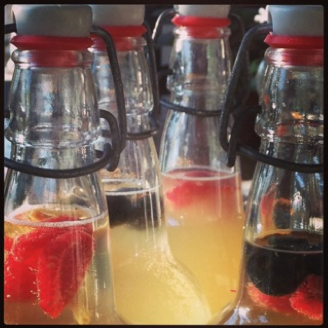 There are many great recipes for flavors, you can look them up. My favorite so far has been grated ginger with lemon and grated ginger with grapefruit juice. A customer suggested the grapefruit juice to me one day in the store, and he was right. Use organic juice, or better yet fresh squeezed if you are really ambitious. I add a 1/4 cup of juice per bottle of ‘bucha. The sugar from the fruit and the juice you use will give you more bubbly.
There are many great recipes for flavors, you can look them up. My favorite so far has been grated ginger with lemon and grated ginger with grapefruit juice. A customer suggested the grapefruit juice to me one day in the store, and he was right. Use organic juice, or better yet fresh squeezed if you are really ambitious. I add a 1/4 cup of juice per bottle of ‘bucha. The sugar from the fruit and the juice you use will give you more bubbly.
Here are some flavor suggestions I found online from other brewers. I think the ideas are endless as long as you have the time to experiment and you take care of mother scoby.
- Blueberries and cinnamon
- Berries and fresh or candied ginger
- Strawberries and basil
- Cherries and almond extract
- Pears and almond extract
- Apple juice and cinnamon
- Mango and apricot juice
- Pineapple juice, coconut water, and coconut extract
- Fresh or candied ginger
- Lavender and camomile
- Chai spice blend
I like the following recipe a lot.
Ginger Kombucha
SOURCE
Makes 1 gallon
- 3 1/2 quarts water
- 1 cup sugar
- 4 bags black tea (or 1 tablespoon loose tea)
- 4 bags green tea (or 1 tablespoon loose tea)
- 2 cups pre-made unflavored kombucha (from your last homemade batch, or store bought)
- 1 scoby per fermentation jar
- 2- to 3-inch piece fresh ginger (see recipe note)
Special equipment:
- Six 16-oz. glass bottles with plastic lids, swing-top bottles, or clean soda bottles
Directions:
- Bring the water to a boil. Remove from heat and stir in the sugar to dissolve. Drop in the tea and allow it to steep until the water has cooled.
- Depending on the size of your pot, this will take a few hours. Alternatively, you can speed this up by boiling only half the water, letting the tea steep, and then cooling it down with the remaining water.
- Once the tea is cool, remove the tea bags (or strain out the loose tea). Stir in the pre-made kombucha. This makes the tea acidic, which prevents unfriendly bacteria from taking up residence during the first few days of fermentation.
- Pour the mixture into a 1-gallon glass jar with a few layers of cheesecloth or paper towels secured with a rubber band. You can divide this between several jars instead of one big one, but each jar will need its own scoby.
- Keep the fermenting kombucha at room temperature, out of direct sunlight, and where it won’t get jostled. Ferment for 7 to 10 days, checking the kombucha and the scoby periodically.
- With clean hands, gently lift the scoby out of the Kombucha and set it on a clean plate. If you’re planning to make another batch of Kombucha right away, measure out your starter tea from this batch of Kombucha and set it aside for the next batch. Grate ginger finely on a microplane or chop it finely in a food processor; be sure to catch any juices that collect. You should have 1 1/2 to 2 tablespoons of ginger puree and juice. Divide the ginger evenly between all your bottles. (Personally, I love about 1 teaspoon of ginger per bottle!)
- Pour the fermented kombucha (straining, if desired) into the bottles using a small funnel. Leave about an inch of head room in each bottle. Store the bottled kombucha at room-temperature out of direct sunlight and allow 1 to 3 days for the kombucha to carbonate. If you bottled in plastic bottles, the kombucha is carbonated when the bottles are rock-solid; if you bottled in glass, intermittently open one of the bottles to check the carbonation (it will re-carbonate quickly once you put the cap back on).
- Once carbonated, refrigerate the kombucha for at least 4 hours to chill it down. The kombucha will keep in the refrigerator for several weeks. If desired, strain the kombucha as you serve to catch bits of ginger pulp.
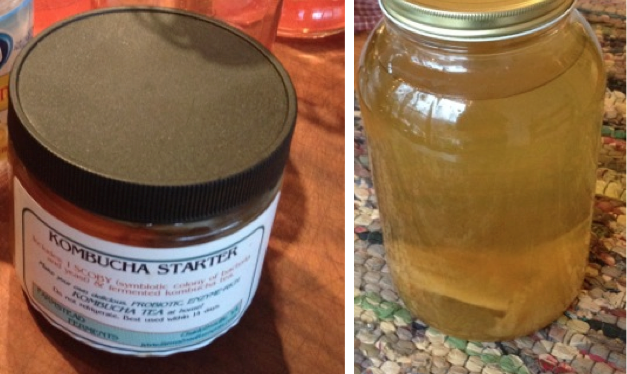
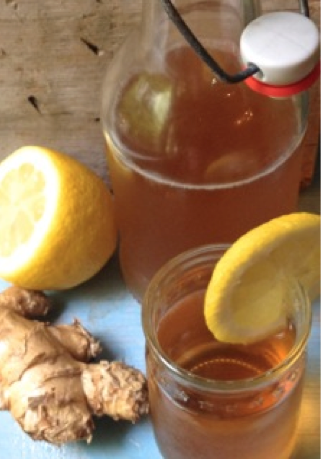

mark fafard says
Hi I am looking for a quality wholesale supplier who sells extract by the gallon or more. Do you know of any?
thanks,
ashley says
For extracts, I would say any soda supplier (like LD Carlson). A lot of local cities will have extract makers – like Crude in Durham https://www.crudebitters.com
Hope this helps, and good luck!
brewdrkombucha says
thanks for the information